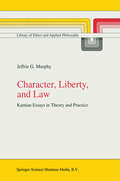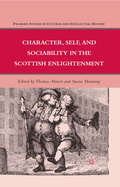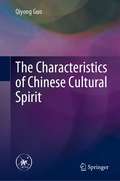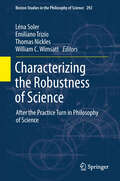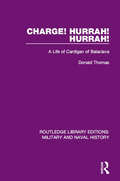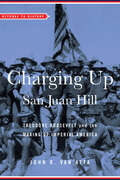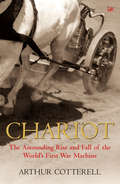- Table View
- List View
Character Evidence in the Courts of Classical Athens: Rhetoric, Relevance and the Rule of Law
by Vasileios AdamidisThere has been much debate in scholarship over the factors determining the outcome of legal hearings in classical Athens. Specifically, there is divergence regarding the extent to which judicial panels were influenced by non-legal considerations in addition to, or even instead of, questions of law. Ancient rhetorical theory and practice devoted much attention to character and it is this aspect of Athenian law which forms the focus of this book. Close analysis of the dispute-resolution passages in ancient Greek literature reveals striking similarities with the rhetoric of litigants in the Athenian courts and thus helps to shed light on the function of the courts and the fundamental nature of Athenian law. The widespread use of character evidence in every aspect of argumentation can be traced to the Greek ideas of ‘character’ and ‘personality’, the inductive method of reasoning, and the social, political and institutional structures of the ancient Greek polis. According to the author’s proposed method of interpretation, character evidence was not a means of diverting the jury’s attention away from the legal issues; instead, it was a constructive and relevant way of developing a legal argument.
Character, Liberty and Law: Kantian Essays in Theory and Practice (Library of Ethics and Applied Philosophy #3)
by J.G. MurphyJeffrie G. Murphy's third collection of essays further pursues the topics of punishment and retribution that were explored in his two previous collections: Retribution, Justice and Therapy and Retribution Reconsidered. Murphy now explores these topics in the light of reflections on issues that are normally associated with religion: forgiveness, mercy, and repentance. He also explores the general issue of theory and practice and discusses a variety of topics in applied ethics - e.g., freedom of artistic expression, the morality of gambling, and the value of forgiveness in psychological counseling. As always, his perspective may be described as Kantian; and, indeed, this collection contains the first extended piece of Kant scholarship that he has done in years: a long essay on Kant on theory and practice.
The Character of God: Recovering the Lost Literary Power of American Protestantism (Religion in America)
by Thomas E. JenkinsEducated people have become bereft of sophisticated ways to develop their religious inclinations. A major reason for this is that theology has become vague and dull. In The Character of God, author Thomas E. Jenkins maintains that Protestant theology became boring by the late nineteenth century because the depictions of God as a character in theology became boring. He shows how in the early nineteenth century, American Protestant theologians downplayed biblical depictions of God's emotional complexity and refashioned his character according to their own notions, stressing emotional singularity. These notions came from many sources, but the major influences were the neoclassical and sentimental literary styles of characterization dominant at the time. The serene benevolence of neoclassicism and the tender sympathy of sentimentalism may have made God appealing in the mid-1800s, but by the end of the century, these styles had lost much of their cultural power and increasingly came to seem flat and vague. Despite this, both liberal and conservative theologians clung to these characterizations of God throughout the twentieth century. Jenkins argues that a way out of this impasse can be found in romanticism, the literary style of characterization that supplanted neoclassicism and sentimentalism and dominated American literary culture throughout the twentieth century. Romanticism emphasized emotional complexity and resonated with biblical depictions of God. A few maverick religious writers-- such as Harriet Beecher Stowe, W. G. T. Shedd, and Horace Bushnell--did devise emotionally complex characterizations of God and in some cases drew directly from romanticism. But their strange and sometimes shocking depictions of God were largely forgotten in the twentieth century. s use "theological" as a pejorative term, implying that an argument is needlessly Jenkins urges a reassessment of their work and a greaterin understanding of the relationship between theology and literature. Recovering the lost literary power of American Protestantism, he claims, will make the character of God more compelling and help modern readers appreciate the peculiar power of the biblical characterization of God.
The Character of John Adams (Published by the Omohundro Institute of Early American History and Culture and the University of North Carolina Press)
by Peter ShawThe formal side of Adams is reconciled with his remarkably colorful private life by Shaw's penetrating grasp of the whole man. Considerable attention is given to his clash of wills with Franklin in Europe and his later relationship with Jefferson. The account of Adams's twenty-five years of retirement after losing the presidency resolves some of the dilemmas arising from the long career of a man who was never really suited by temperament for politics.Originally published in 1976.A UNC Press Enduring Edition -- UNC Press Enduring Editions use the latest in digital technology to make available again books from our distinguished backlist that were previously out of print. These editions are published unaltered from the original, and are presented in affordable paperback formats, bringing readers both historical and cultural value.
The Character of Nations: How Politics Makes and Breaks Prosperity, Family, and Civility
by Angelo CodevillaIn this cross-cultural study, Angelo M. Codevilla illustrates that as people shape their governments, they shape themselves. Drawing broadly from the depths of history, from the Roman republic to de Tocqueville's America, as well as from personal and scholarly observations of the world in the twentieth century, The Character of Nations reveals remarkable truths about the effects of government on a society's economic arrangements, moral order, sense of family life, and ability to defend itself. Codevilla argues that in present-day America, government has had a profound negative effect on societal norms. It has taught people to seek prosperity through connections with political power; it has fostered the atrophy of civic responsibility; it has waged a Kulturkampf against family and religion; and it has dug a dangerous chasm between those who serve in the military and those who send it in harm's way. Informative and provocative, The Character of Nations shows how the political decisions we make have higher stakes than simply who wins elections.
The Character of Nations: How Politics Makes and Breaks Prosperity, Family, and Civility
by Angelo CodevillaIn the aftermath of the Cold war, people around the globe are reexamining and reinventing their political systems, conscious that political choices imply different ways of life. In this new cross-cultural study, Angelo M. Codevilla illustrates that as people shape their governments, they shape themselves. Drawing broadly from the sweep of history, from the Roman republic to de Tocqueville's America, as well as from personal and scholarly observations of the world in the twentieth century, The Character of Nations reveals remarkable truths about the effects of government on a society's economic arrangenments, moral order, sense of family life, and ability to defend itself. Codevilla argues that in present-day America government has had a profound negative effect on societal norms. It has taught people to seek prosperity through connections with political power; it has fostered the atrophy of civic responsibility; it has waged a Kulturkampf against family and religion; and it has dug a dangerous schasm between those who serve in the military and those who send it in harm's way. Informative and provocative, The Character of Nations shows how the political decisions we make have higher stakes than simply who wins elections.
Character, Self, and Sociability in the Scottish Enlightenment (Palgrave Studies in Cultural and Intellectual History)
by Thomas Ahnert and Susan ManningAn interdisciplinary examination of the Enlightenment character and its broader significance. Whilst the main focus of the book is the Scottish Enlightenment, contributors also employ a transatlantic scope by considering parallel developments in Europe, and America.
A Characterisation of Economic Romanticism
by V. I. LeninVladimir Ilich Ulyanov (1870-1924), who took the name of Lenin in 1901, published a series of articles in 1897 that he titled A Characterization of Economic Romanticism.
Characterising Neighbourhoods: Exploring Local Assets of Community Significance (PDF)
by Richard Guise James WebbIt is increasingly important to define what constitutes the unique character of our neighbourhoods, in order to identify what we value and should protect, to pinpoint areas for improvement and places which could be enhanced through sensitive change. But how do we define ‘character’ or a ‘sense of place’? How do we appraise the setting and site of a development area, in order that the essential character is retained and reflected in the design of new development? How can these qualities be communicated to decision makers and involve communities? Characterising Neighbourhoods provides an accessible and richly illustrated guide to the practical methods of appraising neighbourhoods which are precise, well informed and engaging. It demonstrates how characterisation is used as an evidence base for the planning and management of neighbourhoods and urban areas. The core focus is on a proven characterisation method developed and used by the authors and used by community groups, schools, planning and urban design students and professionals. It creates a common language used by these groups in evaluating places. This guide provides a wealth of supporting information, including; briefing on the recognition of local architectural styles, periods and materials, detecting the influence of historic street layouts and property boundaries, townscape concepts such as scale and enclosure, and topographical characteristics. Characterising Neighbourhoods is a valuable resource for practicing planners, urban designers and environmental professionals as well as students in these subjects.
Characterising Neighbourhoods: Exploring Local Assets of Community Significance
by Richard Guise James WebbIt is increasingly important to define what constitutes the unique character of our neighbourhoods, in order to identify what we value and should protect, to pinpoint areas for improvement and places which could be enhanced through sensitive change. But how do we define ‘character’ or a ‘sense of place’? How do we appraise the setting and site of a development area, in order that the essential character is retained and reflected in the design of new development? How can these qualities be communicated to decision makers and involve communities? Characterising Neighbourhoods provides an accessible and richly illustrated guide to the practical methods of appraising neighbourhoods which are precise, well informed and engaging. It demonstrates how characterisation is used as an evidence base for the planning and management of neighbourhoods and urban areas. The core focus is on a proven characterisation method developed and used by the authors and used by community groups, schools, planning and urban design students and professionals. It creates a common language used by these groups in evaluating places. This guide provides a wealth of supporting information, including; briefing on the recognition of local architectural styles, periods and materials, detecting the influence of historic street layouts and property boundaries, townscape concepts such as scale and enclosure, and topographical characteristics. Characterising Neighbourhoods is a valuable resource for practicing planners, urban designers and environmental professionals as well as students in these subjects.
The Characteristics of Chinese Cultural Spirit
by Qiyong GuoThis book discusses issues like the characteristics of Chinese cultural spirit, life wisdom of Confucianism, Buddhism, and Daoism, the management wisdom of traditional Chinese culture, features of Chinese philosophy, as well as the definition of guoxue, or Chinese studies. Referring to previous research, the author defines the characteristics of the traditional Chinese cultural spirit as creating harmony amid diversity and viewing the outside world with a broad mind; being vigorous and self-motivated with tenacious vitality; taking benevolence and righteousness as supreme and being independent; considering people as the basis of the nation; thinking systematically and dialectically; and being pragmatic and thrifty. This book is beneficial to studies on cultural awareness, civilization comparison, as well as civilization exchange.
Characterizing the Robustness of Science: After the Practice Turn in Philosophy of Science (Boston Studies in the Philosophy and History of Science #292)
by Léna Soler, Emiliano Trizio, Thomas Nickles and William WimsattMature sciences have been long been characterized in terms of the “successfulness”, “reliability” or “trustworthiness” of their theoretical, experimental or technical accomplishments. Today many philosophers of science talk of “robustness”, often without specifying in a precise way the meaning of this term. This lack of clarity is the cause of frequent misunderstandings, since all these notions, and that of robustness in particular, are connected to fundamental issues, which concern nothing less than the very nature of science and its specificity with respect to other human practices, the nature of rationality and of scientific progress; and science’s claim to be a truth-conducive activity. This book offers for the first time a comprehensive analysis of the problem of robustness, and in general, that of the reliability of science, based on several detailed case studies and on philosophical essays inspired by the so-called practical turn in philosophy of science.
Characters of Cricket
by Dan WhitingCricket is a game that has always attracted mavericks and characters. Cantankerous batsman, lethal bowlers, criminal wicket keepers and philandering fielders feature as The Middle Stump looks at the good, the bad and the potentially dangerous of the cricket world. Dan has interviewed some of the biggest names in the game and those sitting on the knolls in the sun, and has spoken to everyone who is anyone in the cricket world. Now, based on years of cricket fandom and limited ability, he has collected the portraits of the most interesting players from recent years. Written in the same tongue-in-cheek and honest style that we have all come to love from The Middle Stump.
The Characters of Theophrastos. The Mimes of Herodas. The Tablet of Kebes. (Routledge Revivals)
by R. Thomson ClarkFirst published in 1909, in an era of receding interest in Classical authors, this volume aimed to encourage a renewed interest in the Classics through shared emotion, humanity and the everyday. Attributing the disinterest to a lack of familiarity and a public difficulty for empathising with antiquity, Clark believed literature of the day owed a great deal to the Classical authors, and that its techniques could only be fully understood through their example. He chose Theophrastos, a philosopher and sketch artist, Herodas, a writer of mimes, and the Thebes tablet, a dialogue, with the hope that they would demonstrate how vividly changeless the nature of men and women can be. These translations were designed to be popular and readable, with nothing obscure for the light reader, in order to encourage rediscovery of literature’s Classical roots.
The Characters of Theophrastos. The Mimes of Herodas. The Tablet of Kebes. (Routledge Revivals)
by R. Thomson ClarkFirst published in 1909, in an era of receding interest in Classical authors, this volume aimed to encourage a renewed interest in the Classics through shared emotion, humanity and the everyday. Attributing the disinterest to a lack of familiarity and a public difficulty for empathising with antiquity, Clark believed literature of the day owed a great deal to the Classical authors, and that its techniques could only be fully understood through their example. He chose Theophrastos, a philosopher and sketch artist, Herodas, a writer of mimes, and the Thebes tablet, a dialogue, with the hope that they would demonstrate how vividly changeless the nature of men and women can be. These translations were designed to be popular and readable, with nothing obscure for the light reader, in order to encourage rediscovery of literature’s Classical roots.
Charco Harbour (Classic Australian Works)
by Godfrey BlundenThe story of the legendary Captain James Cook.It is 1768. War has broken out in Europe and the British Admiralty wants a base in the Western Pacific.So Captain James Cook and a company of nearly a hundred seamen and philosophers are despatched into those beautiful but perilous seas that lie between Terra Australis Incognita and the Great Barrier Reef, the never-before-penetrated realm of fin-back whales, sea-serpents, manatee, turtles and sharks, a maze of coral reefs and thousands of islets, some of which mysteriously send the compass needle spinning...Inevitably they are wrecked. After twenty-three hours on the rocks they claw-off and limp into a desolate mainland river estuary, greeted by cries of 'Charco!' from invisible inhabitants. For forty-nine days they are castaway in Charco Harbour, neaped by tides and imprisoned by contrary winds, making contact with one of the strangest and most mysterious of native societies, since lost to the world.In this closely-researched novel the reader will meet the Cook of the old logs and contemporary chronicles, the Cook who dominated mutinous crewmen and complaining passengers by sheer will and temper... the rall red-headed Yorkshiremen, the ex-collier's mate who could knock a man down with his fist, the flogging Captain, the Cook who neither drank nor smoked but could not resist peeping at native women through his spyglass... Cook the anti-hero, albeit the nonpareil of Navigators.
Charge!: The Interesting Bits of Military History
by Justin PollardWar brings out the very best and worst in people although, frankly, its usually the latter. But for all our thousands of years of practice at this most dangerous art there is precious little evidence that we're either outgrowing it or getting any good at it. It is an occupation filled with heroism, genius, hubris, idiocy and blind panic all bought on at least in part by large measures of astonishingly good and bad luck - and they're all here in Charge! This is not a book filled with battle diagrams swarming with arrows or 100,000 word descriptions of the tactical basis for the Pastry War. It is a book about the smaller tragedies and triumphs that actually go to make up the big picture - toilets that sink U-boats, unsporting attacks on Christmas day, armies that stop for tea, bombs on renegade balloons, drunk generals, blind kings, blind drunk generals, circular warships, and all the joy and misery that such things bring with them. And an interesting bit about the Pastry War.
Charge! Hurrah! Hurrah!: A Life of Cardigan of Balaclava (Routledge Library Editions: Military and Naval History)
by Donald ThomasFor James Thomas Brudenell, 7th Earl of Cardigan, leading the Light Brigade at Balaclava was but one incident in a life of sensation and notoriety. Donald Thomas’s biography, originally published in 1977, and based on new material when originally published, shows this most controversial Victorian against a panorama of regimental intrigue and aristocratic luxury. Dismissed from the army for ‘revolting’ conduct, Cardigan bought the command of the 11th Hussars (the ‘Cherry Bums’) for £40,000 a few years later. Regimental rivalries led to the ‘Black Bottle’ scandal of 1840 and to a duel in which he shot a brother officer. Charged with attempted murder, Cardigan was the only Victorian peer to be tried by the House of Lords. Nonetheless, his seductions of other men’s wives rivalled his regimental misdemeanours in press reports. He was jeered int he streets, hissed at the theatre and burnt in effigy. It took the glory and the folly of Balaclava to turn ‘this plague-spot of the British army’ into ‘the most popular soldier in England’. Greeted everywhere by cheering crowds, their new hero fought duels and libel actions against those who denied his bravery before the Russian guns. For all his misbehaviour, Cardigan remains warm-blooded, generous, impulsive and courageous, as well as obstinate, proud and sometimes ridiculous. Hated by numerous men, and adored by many women, his elopement with the beautiful Adeline Horsey de Horsey was a triumph of his old age.
Charge! Hurrah! Hurrah!: A Life of Cardigan of Balaclava (Routledge Library Editions: Military and Naval History)
by Donald ThomasFor James Thomas Brudenell, 7th Earl of Cardigan, leading the Light Brigade at Balaclava was but one incident in a life of sensation and notoriety. Donald Thomas’s biography, originally published in 1977, and based on new material when originally published, shows this most controversial Victorian against a panorama of regimental intrigue and aristocratic luxury. Dismissed from the army for ‘revolting’ conduct, Cardigan bought the command of the 11th Hussars (the ‘Cherry Bums’) for £40,000 a few years later. Regimental rivalries led to the ‘Black Bottle’ scandal of 1840 and to a duel in which he shot a brother officer. Charged with attempted murder, Cardigan was the only Victorian peer to be tried by the House of Lords. Nonetheless, his seductions of other men’s wives rivalled his regimental misdemeanours in press reports. He was jeered int he streets, hissed at the theatre and burnt in effigy. It took the glory and the folly of Balaclava to turn ‘this plague-spot of the British army’ into ‘the most popular soldier in England’. Greeted everywhere by cheering crowds, their new hero fought duels and libel actions against those who denied his bravery before the Russian guns. For all his misbehaviour, Cardigan remains warm-blooded, generous, impulsive and courageous, as well as obstinate, proud and sometimes ridiculous. Hated by numerous men, and adored by many women, his elopement with the beautiful Adeline Horsey de Horsey was a triumph of his old age.
The Charge of the Light Brigade: The British Film Guide 5
by Mark ConnellyTony Richardson's 1968 "Charge of the Light Brigade", with its star cast, lavish sets and location shoots, was one of the most expensive British films ever made. Mark Connelly examines the film, its production, the role of its stars David Hemmings, Vanessa Redgrave and John Gieldgud, and director Richardson's running feud with the press and the film's subsequent fame. He shows the film to be representative of its time, in its visual style and its use of 60s themes, to discuss how "Charge of the Light Brigade", while meticulously reconstructed from authentic sources, reveals the horror of war to a world struggling to come to terms with American involvement in Vietnam.
Charging Up San Juan Hill: Theodore Roosevelt and the Making of Imperial America (Witness to History)
by John R. Van AttaBelow a Cuban sun so hot it stung their eyes, American troops hunkered low at the base of Kettle Hill. Spanish bullets zipped overhead, while enemy artillery shells landed all around them. Driving Spanish forces from the high ground would mean gaining control of Santiago, Cuba, and, soon enough, American victory in the Spanish-American War. No one doubted that enemy fire would claim a heavy toll, but these unusual citizen-soldiers and their unlikely commander;¢;‚¬;€?39-year-old Colonel Theodore Roosevelt;¢;‚¬;€?had volunteered for exactly this kind of mission.In Charging Up San Juan Hill, John R. Van Atta recounts that fateful day in 1898. Describing the battle;€™s background and its ramifications for Roosevelt, both personal and political, Van Atta explains how Roosevelt;€™s wartime experience prompted him to champion American involvement in world affairs. Tracking Roosevelt;€™s rise to the presidency, this book argues that the global expansion of American influence;¢;‚¬;€?indeed, the building of an empire outward from a strengthened core of shared values at home;¢;‚¬;€?connected to the broader question of cultural sustainability as much as it did to the increasing of trade, political power, and military might.At the turn of the twentieth century, Theodore Roosevelt personified American confidence. A New York City native and recovered asthmatic who spent his twenties in the wilds of the Dakota Territory, Roosevelt leapt into the war with Spain with gusto. He organized a band of cavalry volunteers he called the Rough Riders and, on July 1, 1898, took part in their charge up a Cuban hill the newspapers called San Juan, launching him to national prominence. Without San Juan, Van Atta argues, Roosevelt;¢;‚¬;€?whom the papers credited for the victory and lauded as a paragon of manhood;¢;‚¬;€?would never have reached a position to become president.
Charging Up San Juan Hill: Theodore Roosevelt and the Making of Imperial America (Witness to History)
by John R. Van AttaBelow a Cuban sun so hot it stung their eyes, American troops hunkered low at the base of Kettle Hill. Spanish bullets zipped overhead, while enemy artillery shells landed all around them. Driving Spanish forces from the high ground would mean gaining control of Santiago, Cuba, and, soon enough, American victory in the Spanish-American War. No one doubted that enemy fire would claim a heavy toll, but these unusual citizen-soldiers and their unlikely commander;¢;‚¬;€?39-year-old Colonel Theodore Roosevelt;¢;‚¬;€?had volunteered for exactly this kind of mission.In Charging Up San Juan Hill, John R. Van Atta recounts that fateful day in 1898. Describing the battle;€™s background and its ramifications for Roosevelt, both personal and political, Van Atta explains how Roosevelt;€™s wartime experience prompted him to champion American involvement in world affairs. Tracking Roosevelt;€™s rise to the presidency, this book argues that the global expansion of American influence;¢;‚¬;€?indeed, the building of an empire outward from a strengthened core of shared values at home;¢;‚¬;€?connected to the broader question of cultural sustainability as much as it did to the increasing of trade, political power, and military might.At the turn of the twentieth century, Theodore Roosevelt personified American confidence. A New York City native and recovered asthmatic who spent his twenties in the wilds of the Dakota Territory, Roosevelt leapt into the war with Spain with gusto. He organized a band of cavalry volunteers he called the Rough Riders and, on July 1, 1898, took part in their charge up a Cuban hill the newspapers called San Juan, launching him to national prominence. Without San Juan, Van Atta argues, Roosevelt;¢;‚¬;€?whom the papers credited for the victory and lauded as a paragon of manhood;¢;‚¬;€?would never have reached a position to become president.
Chariot: The Astounding Rise and Fall of the World's First War Machine
by Arthur CotterellThe chariot changed the face of ancient warfare. First in West Asia and Egypt, then in India and China, charioteers came to dominate the battlefield. Its use as a war machine is graphically recounted in Indian epics and Chinese chronicles. Homer's Iliad tells of the attack on Troy by Greek heroes who rode in chariots. In 326 BC Alexander the Great faced charioteers in northern India, while in 55 BC, on a Kent beach, Julius Caesar was met by British chariots. Because of the danger involved, chariot racing attracted hundreds of thousands of spectators. So enthusiastic were they that the Roman emperor Nero could not resist driving his own ten-horse chariot at the Olympic Games: he fell out but still won the prize. Rivalry between groups of spectators at chariot races often ignited urban riots. In Constantinople, in 532 AD, a three-day disturbance left 30,000 dead.
Chariot in Indian History
by U.P. ThapliyalThe invention and development of the chariot around the third millennium revolutionized the art of warfare and dominated the battlefields for some 3000 years. It seems to have evolved in the borderlands between the steppes and the riverlands. It is believed that the Āryan borrowed the idea of chariot from Sumerians around 2000 bc.It is presumed that these Āryans entered Iran and departed in three branches. One marches westward towards Syria, another eastward towards India and a third stays back in Iran. The absence of chariot in Indus valley civilization suggests that chariot arrived in India with Āryans, who settled here around 1500 bc. They used it as a lethal war machine to conquer the natives. The Chariot has played a vital role in Indian warfare through the ages, spanning over Vedic, Epic, and Puranic times, as attested to by literary and archaeological evidence. The Turk invasion marked by the dominance of cavalry arm brought the curtain down on chariot as a war machine. However, it survived in the Indian milieu in some other incarnations.

